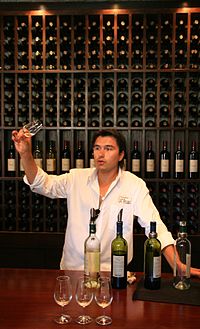
Photo from wikipedia
Abstract Plasticity improvement in metallic glasses resulting from cycling treatment between room and liquid nitrogen temperature has been reported and attributed to rejuvenation due to a non-uniform thermal expansion coefficient.… Click to show full abstract
Abstract Plasticity improvement in metallic glasses resulting from cycling treatment between room and liquid nitrogen temperature has been reported and attributed to rejuvenation due to a non-uniform thermal expansion coefficient. However, the detailed microscopic effect is still unclear. The present study focuses on the microscopic effect of room-temperature ageing and cryogenic cycling. La70Cu15Al15 and La70Ni15Al15 metallic glasses were subjected to varying ageing times, after which some were also cryogenically cycled. Quasi-static anelastic relaxation measurements were then employed to characterize the time-constant spectra over seven orders of magnitude. The overall anelastic strain decreases with increasing ageing time, but is not noticeably affected by cryogenic cycling. On the other hand, while ageing also causes an increase in characteristic time constants, cycling reverses this effect. The new details shed light on the effect of structural relaxation and rejuvenation on the properties of shear transformation zones.
Journal Title: Acta Materialia
Year Published: 2019
Link to full text (if available)
Share on Social Media: Sign Up to like & get
recommendations!